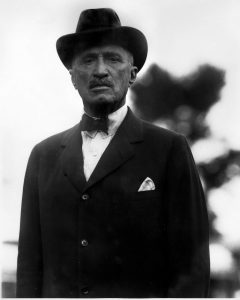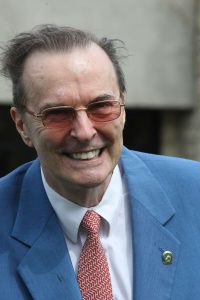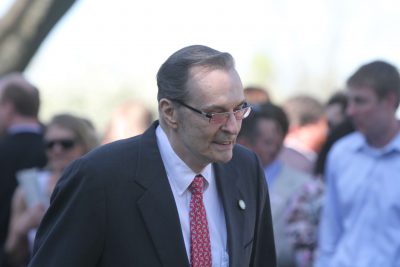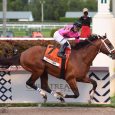By Maryjean Wall
I’m certain you’ll hear a lot more horse talk in the clouds now, following the recent death of Preston Madden, owner of Hamburg Place and breeder of Kentucky Derby and Preakness winner, Alysheba. Imagine him catching up in heaven with his grandfather, John E. Madden, who died in 1929.

John Madden – Photo courtesy Keeneland Library/Charles Cook collection
John Madden, notorious two-fisted gambler and founder of Hamburg Place in 1898, was called the Wizard of the Turf. He was responsible for six Kentucky Derby and five Belmont Stakes winners.
“Presto,” the old Wizard might have said upon greeting his grandson from his own puffy cloud, “I’ve been waiting since 1929 for you to get up here, just so I could tell you this: you never should have taken Alysheba at 4-5 in the Belmont Stakes.”
A poor return on investment is still a bad bet, whether John Madden was outsmarting the on-track bookmakers or when “Presto” enjoyed his racing under the pari-mutuel system.
If Alysheba had won the 1987 Belmont (he ran fourth to Bet Twice) he wouldn’t have paid enough to make the risk worthwhile. John Madden did not like those bets. And yet: Alysheba would have given Hamburg Place its second Triple Crown winner if he’d won the Belmont. Sir Barton in 1919 was the first for Hamburg Place.
Think about it: six Derby and five Belmont winners during the grandfather’s tenure, either as breeder or as owner (and sometimes, trainer). Then another Derby and a near miss in the Triple Crown for the grandson. No other farm except Calumet, with nine Derby winners, could claim numbers like these.
Preston loved to take his visitors down to the old foaling barn and say that six of the farm’s seven Derby winners were born in that very barn. The six were Old Rosebud, Sir Barton, Paul Jones, Zev, Flying Ebony and Alysheba.
Grandfather Madden’s seventh Derby winner that he owned (but did not breed) was Plaudit. The barn was nothing fancy and nothing like the show places on modern farms. Still, it got the job done better than all the modern barns collectively.

Preston Madden-Photos by Z/Keeneland. – April, 2008
Preston and his wife, Anita, who died in 2018, were as famous for their extravagant Kentucky Derby parties as for the horses they bred and raised. But as they were well aware, the story of Hamburg did not begin with them.
It began in the steel mills at Bethlehem, Pennsylvania, where John Madden was born in 1856 to Irish immigrant parents. John’s father, Patrick, worked in the zinc mines.
Four years following the birth of young John, Patrick died and left his wife with a daughter and two sons to raise. They did not have much in the way of money or material goods. This did not slow son John.
John developed into an athlete during his youth, excelling at boxing and running. His exposure to both sports at county fairs introduced him to harness racing, because the trotters were the other big attraction at these fairs. Soon, Madden wasn’t just watching the trotting races. He learned to drive trotters.
He acquired a cheap trotting horse. He developed the skills he needed to keep trading up. He learned to wheel and deal and at age 30 in 1889, went for the big time: he moved to Lexington, Kentucky, with a $150,000 bank roll and a well-established reputation for buying and selling high-priced trotters.
Soon Madden realized that the future lay not in trotters but in thoroughbreds. Shrewd dealer that he was, he followed the money.
Madden worked his way up in thoroughbreds with the same good eye he had developed for horses and the same shrewdness he had learned to bring to any deal. He also worked his way through the betting rings, back when on-track bookmakers were the only means to get down a wager at the race track.
Madden made a major score at old Aqueduct in 1909 on a horse he owned, winning a $1,500 purse. He took the winner’s purse, yes, but he also walked away from the betting ring with an extra $100,000. This was nothing unusual for him.
Everything Madden touched turned to big money. As Kent Hollingsworth described in John E. Madden of Hamburg Place, the man turned horses into gold bricks: his most notorious turnover was Hamburg, bought in 1896 for $1,200 and later resold following a championship season for a record $40,001.
Madden used this windfall to purchase 235 acres, situated in the countryside outside Lexington, that he promptly named Hamburg Place.
At Hamburg Place he began to breed and raise his own stock to sell, expanding his farm to 2,000 acres. He became a millionaire, back when that was a financial goal few could hope to reach.
His Derby and Belmont Stakes wins were legendary. But he didn’t rest with his new success. He resurrected his interest in trotters as a sideline to thoroughbreds.

Preston Madden-Photos by Z/Keeneland. April, 2010
He won the Kentucky Futurity, a race recognized as one in a trio of events comprising trotting’s Triple Crown.
At the time of his death in 1929, Madden had been the leading thoroughbred breeder in the United States from 1917 to 1923 and 1925. He bred 14 champions.
John Madden’s two sons did not choose to engage in the thoroughbred business, one of them preferring to raise polo ponies. But John Madden’s grandson, Preston, resurrected Hamburg as a racehorse farm in a big way, beginning in 1956.
One early coup was standing T. V. Lark at stud. The horse was a descendant of the great Nearco, through Nasrullah, and in 1974 he became the leading sire in the United States. Preston and Anita Madden were a longtime presence at the Keeneland Sales. Hamburg Place was back on the map.
During the 1980s the Madden family began developing much of the 2,000 acres John Madden had acquired nearly a century earlier.
The property became the site of a shopping center (Hamburg Pavilion), of residential development, and other commercial sites. Most of the city streets and roads situated in or nearby these recently developed properties were named for famous Hamburg horses, including Alysheba.
John Madden is remembered today for building a dynasty at Hamburg Place using common sense horsemanship spiced with an unmatched knowledge of the horse.
Preston Madden carried his grandfather’s vision into modern times and now John’s great-grandson, Patrick Madden, has used his own vision and expertise in real estate law to carry Hamburg Place into a new role better suited to modern times.
The story has spanned more than a century and if Patrick Madden or his children choose to reprise the family’s background in racing, the story might not be over yet.
If you enjoyed this piece, check out other articles at our horse racing news section!




